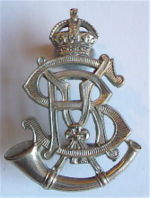Simla Rifles: Difference between revisions
details |
No edit summary |
||
| Line 20: | Line 20: | ||
*Badge - The Monogram "S.R." surmounted by a crown, pendant therefrom a bugle horn stringed. "The Simla Rifles, A.F.I." on a scroll underneath. | *Badge - The Monogram "S.R." surmounted by a crown, pendant therefrom a bugle horn stringed. "The Simla Rifles, A.F.I." on a scroll underneath. | ||
*Motto - "In Defence" | *Motto - "In Defence" | ||
==Cadets== | |||
In 1884 Bishop Cotton School (BCS) introduces and joins “D Coy” Simla Volunteer Rifles<ref>[http://oldcottonians.org/magazine/our-heritage/ Heritage] Old Cottonians.org</ref> | |||
In 1947, Freddie Brown, schoolmaster at BCS, along with the British & Hindu boys had to ensure that 42 Pakistani boys were not harmed. Between 15 August to 21 Oct 1947, at night, under Freddie’s supervision, armed guards from the Simla Rifles cadets patrolled the dormitories, until the Pakistani boys were safely evacuated.<ref> | |||
[http://www.oldcottonians.org/webletters/newsletterAug2006.htm Old Cottonians Newsletter August 2006]</ref> | |||
==Individuals== | |||
Henry Mortimer Durand, ‘Boundary-Maker’ and ‘Peace-Maker’ was Foreign Secretary. In the autumn of 1889, his health broke down and he was sent home on long furlough. On his return to India, he was invited to take command of the somewhat run down Simla Volunteers. Characteristically he took his part-time soldiering extremely seriously, and, in the spirit of the ‘inherited traditions of the Mutiny’, told the Volunteers, “Practice is everything. You can no more make war without practice than you can make boots. For the purposes of defence, which is the main business of volunteers, determined men with rifles in their hands can do a great deal, even if they are not highly drilled troops.’<ref>[http://www.dnw.co.uk/medals/auctionarchive/viewspecialcollections/itemdetail.lasso?itemid=42159 Sir Mortimer Durand’s Medals] DNW.co.uk</ref> At Simla he also established the Durand Football Tournament, as recreation for British troops stationed in India,<ref>[http://www.osians.com/fib/durand_origion.php Sir Mortimer Durand] Osians.com</ref> which ultimately became the leading Association event in India. The Simla Rifles reached the finals in 1889, but lost by the largest margin ever, 8-1<ref>[http://www.rsssf.com/tablesi/indiadurandcuphist.html Durand Cup History] from [http://www.rsssf.com/nersssf.html The Rec.Sport.Soccer Statistics Foundation]</ref> | |||
==Notes== | ==Notes== | ||
<references /> | <references /> | ||
==Also see== | |||
[File:Simla Volunteer Rifles Viceroys Cup.jpg] The winning football team in 1914 | |||
==External links== | |||
*[http://www.worthpoint.com/worthopedia/photo-2nd-punjab-vol-rifles-simla-india-by-hotz Photograph of the 2nd Punjab Volunteer Rifles at Annandale Gardens in Simla].1896. Worthpoint.com | |||
*[http://www.flickr.com/photos/hyphcann/4490835904/ Photograph of E. (Major Coates') Company, Simla Volunteer Rifles, Winners of H.E. the Viceroy's Cup, 1913].Flickr.com | |||
[[Category:Auxiliary Force (India)]] | [[Category:Auxiliary Force (India)]] | ||
[[Category:Railway Regiments]] | [[Category:Railway Regiments]] | ||
Revision as of 14:19, 23 July 2010

The Simla Rifles were an auxiliary regiment.
Chronology
- 1861 raised as 2nd Punjab (Simla) Volunteer Rifle Corps on 2nd May[1]
- 1904 renamed the Simla Volunteer Rifles[2]
- 1917 1st April, became the 4th Simla Rifles[2]
- 1920 1st October, redesignated Simla Rifles[2]
Details
In 1901:[3]
- Headquarters - Simla
- Uniform - Khaki serge
- Detachments:
By 1940:[2]
- Uniform - Khaki
- Facings - Rifle Green
- Badge - The Monogram "S.R." surmounted by a crown, pendant therefrom a bugle horn stringed. "The Simla Rifles, A.F.I." on a scroll underneath.
- Motto - "In Defence"
Cadets
In 1884 Bishop Cotton School (BCS) introduces and joins “D Coy” Simla Volunteer Rifles[4]
In 1947, Freddie Brown, schoolmaster at BCS, along with the British & Hindu boys had to ensure that 42 Pakistani boys were not harmed. Between 15 August to 21 Oct 1947, at night, under Freddie’s supervision, armed guards from the Simla Rifles cadets patrolled the dormitories, until the Pakistani boys were safely evacuated.[5]
Individuals
Henry Mortimer Durand, ‘Boundary-Maker’ and ‘Peace-Maker’ was Foreign Secretary. In the autumn of 1889, his health broke down and he was sent home on long furlough. On his return to India, he was invited to take command of the somewhat run down Simla Volunteers. Characteristically he took his part-time soldiering extremely seriously, and, in the spirit of the ‘inherited traditions of the Mutiny’, told the Volunteers, “Practice is everything. You can no more make war without practice than you can make boots. For the purposes of defence, which is the main business of volunteers, determined men with rifles in their hands can do a great deal, even if they are not highly drilled troops.’[6] At Simla he also established the Durand Football Tournament, as recreation for British troops stationed in India,[7] which ultimately became the leading Association event in India. The Simla Rifles reached the finals in 1889, but lost by the largest margin ever, 8-1[8]
Notes
- ↑ Indian Army List 1901 states "Formed by Punjab GO No. 101 of 2nd May 1861 and 171 of 21st October 1861."
- ↑ 2.0 2.1 2.2 2.3 Jackson, Major Donovan India's Army (1940)
- ↑ Indian Army List 1st Sept 1901
- ↑ Heritage Old Cottonians.org
- ↑ Old Cottonians Newsletter August 2006
- ↑ Sir Mortimer Durand’s Medals DNW.co.uk
- ↑ Sir Mortimer Durand Osians.com
- ↑ Durand Cup History from The Rec.Sport.Soccer Statistics Foundation
Also see
[File:Simla Volunteer Rifles Viceroys Cup.jpg] The winning football team in 1914